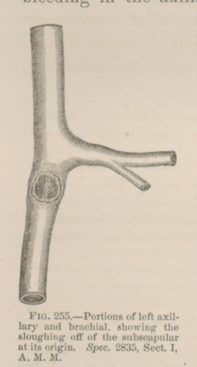Title: Drake, F. M.
Source text: Surgeon General Joseph K. Barnes, United States Army, The Medical and Surgical History of the War of the Rebellion. (1861–65.), Part 1, Volume 2 (Washington, D.C.: Government Printing Office, 1870), 556.
Civil War Washington ID: med.d1e19990
TEI/XML: med.d1e19990.xml
CASE.—Private F. M. Drake, Co. D, 35th North Carolina Regiment, aged 27 years, was struck by a musket ball, at Petersburg, June 16th, 1864, three inches below the left clavicle. The missile made its exit at the posterior border of the left axilla. He was made a prisoner, and sent to Lincoln Hospital on June 25th. He had full extra diet and simple dressings, and nothing of importance occurred until July 10th, when there was profuse arterial bleeding from the exit orifice, stanched by plugging the track of the ball with pledgets of charpie dipped in solution of persulphate of iron, and applying compresses tightly bandaged in the arm-pit. Bleeding recurred, and the patient died on July 12th, 1864. The post-mortem dissection revealed a phagedemic condition of the posterior part of the wound, and the subscapular artery was completely sloughed through at its origin. The specimen was contributed by Acting Assistant Surgeon H. M. Dean; the notes of the case by Acting Assistant Surgeon Thaddeus L. Leavitt, U. S. V.
